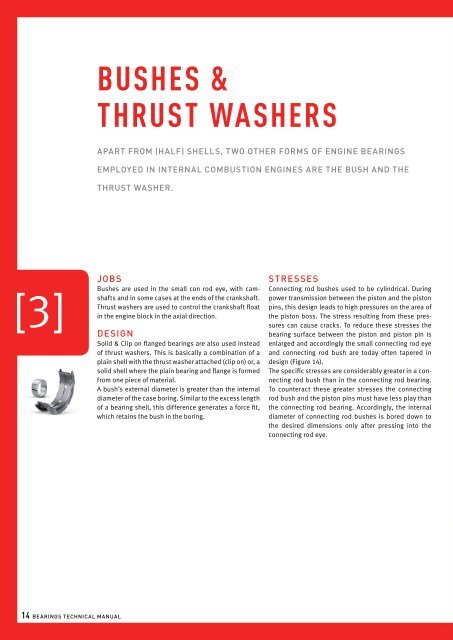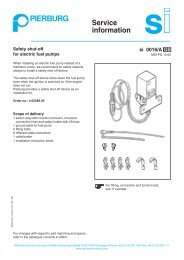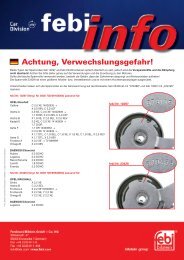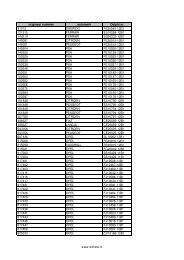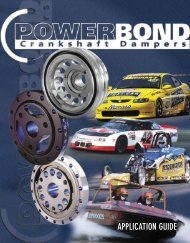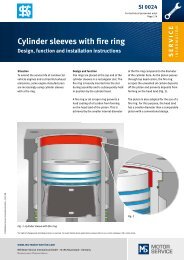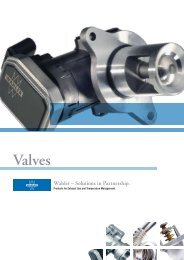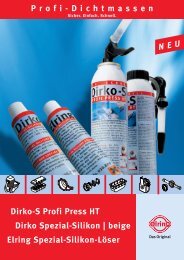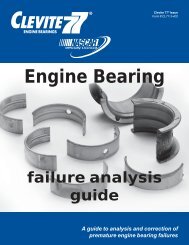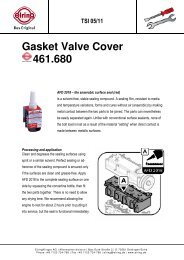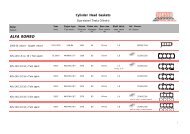EvEry bEaring you nEEd
EvEry bEaring you nEEd
EvEry bEaring you nEEd
Create successful ePaper yourself
Turn your PDF publications into a flip-book with our unique Google optimized e-Paper software.
Bushes &<br />
thrust washers<br />
Apart from (half) shells, two other forms of engine bearings<br />
employed in internal combustion engines are the bush and the<br />
thrust washer.<br />
[fig.12] Dimensions and characteristics<br />
of a small end bush<br />
[1] outer diameter<br />
[2] inner diameter<br />
[3] oil groove<br />
[4] length<br />
[5] oil bore<br />
[6] joint<br />
[7] clinch<br />
[4]<br />
[5]<br />
[fig.13] Dimensions and characteristics<br />
of a thrust washer<br />
[1] wall thickness<br />
[2] sliding surface<br />
[3] lubricating groove<br />
[4] locating lug<br />
[1]<br />
[7]<br />
[3]<br />
[2]<br />
[3]<br />
Jobs<br />
Bushes are used in the small con rod eye, with camshafts<br />
and in some cases at the ends of the crankshaft.<br />
Thrust washers are used to control the crankshaft float<br />
in the engine block in the axial direction.<br />
Design<br />
Solid & Clip on flanged bearings are also used instead<br />
of thrust washers. This is basically a combination of a<br />
plain shell with the thrust washer attached (clip on) or, a<br />
solid shell where the plain bearing and flange is formed<br />
from one piece of material.<br />
A bush’s external diameter is greater than the internal<br />
diameter of the case boring. Similar to the excess length<br />
of a bearing shell, this difference generates a force fit,<br />
which retains the bush in the boring.<br />
Stresses<br />
Connecting rod bushes used to be cylindrical. During<br />
power transmission between the piston and the piston<br />
pins, this design leads to high pressures on the area of<br />
the piston boss. The stress resulting from these pressures<br />
can cause cracks. To reduce these stresses the<br />
bearing surface between the piston and piston pin is<br />
enlarged and accordingly the small connecting rod eye<br />
and connecting rod bush are today often tapered in<br />
design (Figure 14).<br />
The specific stresses are considerably greater in a connecting<br />
rod bush than in the connecting rod bearing.<br />
To counteract these greater stresses the connecting<br />
rod bush and the piston pins must have less play than<br />
the connecting rod bearing. Accordingly, the internal<br />
diameter of connecting rod bushes is bored down to<br />
the desired dimensions only after pressing into the<br />
connecting rod eye.<br />
[fig.14]<br />
[2]<br />
[1]<br />
[6]<br />
[a] The small con rod eye for this piston has a cylindrical<br />
shape which is the traditional shape for piston and con rod.<br />
[3]<br />
[4]<br />
[b] The small con rod eye for this piston has a conical<br />
shape. The conical shape increases the load carrying<br />
surface of the con rod bush and the piston pin. At the same<br />
time, the rigidity of the piston is strengthened. Due to the<br />
larger load carrying surface there is less pressure on con<br />
rod bush and piston pin.<br />
[a]<br />
[b]<br />
14 Bearings Technical Manual<br />
15


